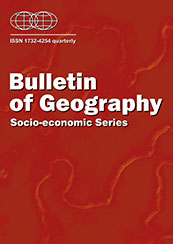Challenging policy barriers in sustainable urban design
DOI:
https://doi.org/10.2478/bog-2018-0013Abstract
In built environment design, codes set minimum health and safety requirements, policies set aspirational targets, and incentives such as green building rating schemes set design standards. These approaches have failed to provide universal wellbeing and environmental justice (i.e. intra-generational equity), or increases in the natural life-support system that exceed depletion rates (i.e. inter-generational equity). Governments that do not ensure all citizens can obtain basic needs, life quality and resource security fail to meet their basic responsibilities. Two recent documents, one representing sustainable urban policy and principles, the other representing urban biodiversity standards, are examined against the Positive Development Test (whether the development increases the public estate, ecological base and future public options). The discussion suggests that contemporary policies and incentive schemes, as presently conceived, cannot provide the basic physical preconditions for sustainability, let alone address socio-economic inequities. An alternative design-based approach is presented to address the issues the paper identified.References
Birkeland, J. editor, 2002: Design for sustainability: A sourcebook of integrated, eco-logical solutions, London: Earthscan. Available at: https://eprints.qut.edu.au/9092/, DoA: 21.02.2018.
Birkeland, J., 2004: Creating net positive design. Canberra: Frank Fenner Foundation. Available at: http://www.natsoc.org.au/our-projects/biosensitivefutures/part-5-social-change/built-environment/positive-developmen t, DoA: 21.02.2018.
Birkeland, J., 2005: Reversing negative impacts by design. In: Chief Minister’s Sustainability Expert Reference Group, editors, Sustainability for the ACT: The Future’s in our Hands. Canberra: Office of Sustainability of the ACT Government, pp. 17–18.
Birkeland, J., 2007: GEN 4: Positive Development – Designing for Net-positive Impacts. Canberra: BEDP (Built Environment Design Professions) and The Royal Australian Institute of Architects Available at: http://www.environmentdesignguide.com.au/, DoA: 21.02.2018.
Birkeland, J., 2008: Positive Development: From vicious circles to virtuous cycles through Built Environment Design. London: Earthscan. Available at: https://eprints.qut.edu.au/25986/, DoA: 21.02.2018.
Birkeland, J., 2014: Systems and social change for sustainable and resilient cities. In: Pearson, L., Newton, P. and Roberts, P. editors, Resilient sustainable cities, London: Routledge, pp. 66-82.
Birkeland, J. and Knight-Lenihan, S., 2016: Biodiversity offsetting and net positive design. In: Journal of Urban Design. Vol. 21(1), pp. 50–66. DOI: 10.1080/13574809.2015.1129891
Birkeland, J. and Schooneveldt, J., 2002: ACT sustainability audit: A material flows analysis of the residential sector of Canberra. Canberra: Planning and Land Management Authority (republished by Land and Water Australia, 2003: Mapping regional metabolism). Available at: https://library.dbca.wa.gov.au/static/FullTextFiles/070622.pdf, DoA: 21.02.2018.
Davidoff, P., 1965: Advocacy and pluralism in planning. In: Journal of the American Institute of Planners. Vol. 31(4), pp. 331–338. DOI: 10.1080/01944366508978187
Demaria, F. and Kothari, A., 2017: The post-development dictionary agenda: paths to the pluriverse. In: Third World Quarterly, Vol. 38(12), pp. 2588–2599. DOI: 10.1080/01436597.2017.1350821
Dymitrow, M. and Halfacree, K., 2018: Sustainability—differently. In: Bulletin of Geography. Socio-economic Series, Vol. 40. DOI: 10.2478/bog-2018-0011
Elliott, L., 2017: World’s eight richest men have the same total wealth as the poorest half of the world population. In: Guardian, 16 January. Available at: https://www.theguardian.com/global-development/2017/jan/16/worlds-eight-richest-people-have-same-wealth-as-poorest-50, DoA: 10.10.2017.
GBCA [Green Building Council of Australia], 2017: Land Use and Ecology Category Review. Sydney: Green Building Council of Australia. Available at: https://gbca.org.au/contact/, DoA: 10.10.2017.
Habitat III, 2016: The new urban agenda (Quito declaration on sustainable cities and human settlements for all). Available at: http://habitat3.org/the-new-urban-agenda/, DoA: 10.10.2017.
Hamilton, C., 1999: The genuine progress indicator methodological developments and results from Australia. In: Ecological Economics, Vol. 30(1), pp. 13–28. DOI: 10.1016/S0921-8009(98)00099-8
Newsham, G.R., Mancini, S. and Birt, B.J., 2009: Do LEED-certified buildings save energy? Yes, but… In: Energy and Buildings, Vol. 41(8), pp. 897-905. DOI: 10.1016/j.enbuild.2009.03.014
Norton, B.G., 2005: Sustainability: A philosophy of adaptive ecosystem management. Chicago: University of Chicago Press.
Rees, W.E., 2002: Box 9: Eco-footprints and eco-logical design. In: Birkeland, J. editor, Design for sustainability: A Sourcebook of integrated eco-logical solutions. London: Earthscan, p. 73.
Register, R., 2006: Ecocity Berkeley: Building cities for a healthy future. Berkeley, CA: North Atlantic Books.
Renger, B.C., Birkeland, J. and Midmore, D., 2015: Net-positive building carbon sequestration. In: Building Research & Information, Vol. 43(1), pp. 11–24. DOI: 10.1080/09613218.2015.961001
Swain, I., 2008: Box 40: Linking policies to outcomes. In: Birkeland, J. editor, Positive Development: From vicious circles to virtuous cycles through Built Environment Design, London: Earthscan, pp. 325–326.
Todd, N.J. and Todd, J., 1994: From eco-cities to living machines. Berkeley: CA: North Atlantic Books.
Wackernagel, M. and Rees, W.E., 1996: Our ecological footprint: Reducing the human impact on the Earth. Gabriola Island, Canada: New Society Publishers.
Wesener, A., McWilliam, W., Tavares, S. and Birkeland, J. editors, 2017: Integrated urban grey and green infrastructures. In: Landscape Review, Vol. 17(2), pp. 1–4.
WWF [World Wildlife Fund], 2016: Living planet report 2016: Risk and resilience in a new era. Gland, Switzerland: WWF. Available at: https://www.wnf.nl/custom/LPR_2016_fullreport/, DoA: 21.02.2018.
Downloads
Published
How to Cite
Issue
Section
License
Copyright (c) 2018 Bulletin of Geography. Socio-economic Series

This work is licensed under a Creative Commons Attribution-NoDerivatives 4.0 International License.
Title, logo and layout of journal Bulletin of Geography. Socio-economic Series are reserved trademarks of Bulletin of Geography. Socio-economic Series.Stats
Number of views and downloads: 860
Number of citations: 9



